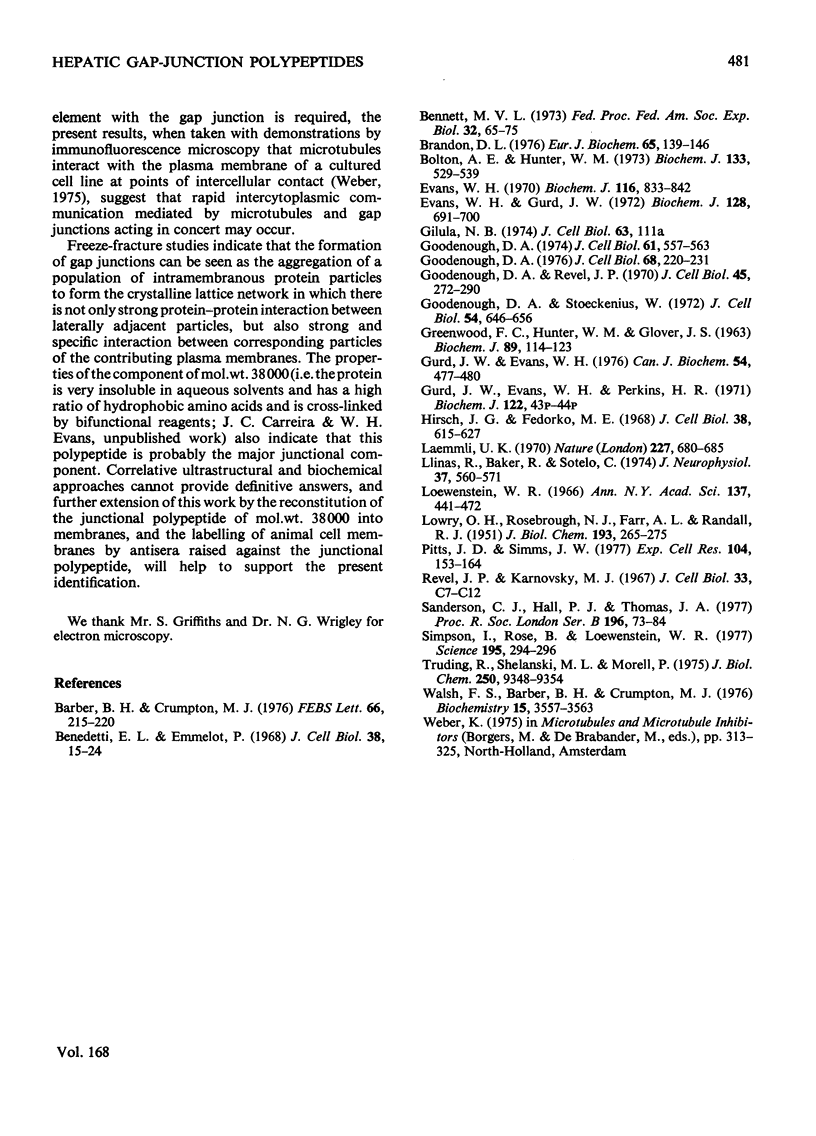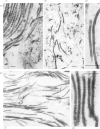Abstract
1. Gap (communicating) junctions are plasma-membrane specializations of characteristic morphology that form transmembrane channels allowing direct communication between cells. Their preparation is described starting from mouse liver plasma membranes and the constituent polypeptides are deduced. 2. Gap junctions co-purify with collagen fibres when the plasma-membrane residues insoluble in N-dodecyl sarcosinate are fractionated on sucrose gradients. Sucrose-density perturbation by relipidation of isolated gap junctions or the use of urea to remove non-junctional membranes both failed to diminish the collagen content of fractions. 3. Removal of collagen by treatment with purified collagenase preparations yielded morphologically satisfactory gap-junction fractions. Analysis by polyacrylamide-gel electrophoresis of the polypeptides present in gap junctions prepared by procedures omitting or using collagenases indicated two non-glycosylated polypeptides, a major component of apparent mol.wt. 38000 and a minor 40000-mol.wt. component. These two polypeptides were also present in plasma membranes and the intermediate fractions. 4. Proteolysis of the gap-junction polypeptides yielding components of mol.wt. 34000, 25000 and below 20000 occurred when iodinated gap junctions were subject to prolonged collagenase treatment, thus explaining the variable polypeptide composition of gap junctions reported by others. 5. The morphological properties of the isolated gap junctions prepared by the various procedures are described.
Full text
PDF











Images in this article
Selected References
These references are in PubMed. This may not be the complete list of references from this article.
- Barber B. H., Crumpton M. J. Actin associated with purified lymphocyte plasma membrane. FEBS Lett. 1976 Jul 15;66(2):215–220. doi: 10.1016/0014-5793(76)80507-8. [DOI] [PubMed] [Google Scholar]
- Benedetti E. L., Emmelot P. Hexagonal array of subunits in tight junctions separated from isolated rat liver plasma membranes. J Cell Biol. 1968 Jul;38(1):15–24. doi: 10.1083/jcb.38.1.15. [DOI] [PMC free article] [PubMed] [Google Scholar]
- Bennett M. V. Function of electrotonic junctions in embryonic and adult tissues. Fed Proc. 1973 Jan;32(1):65–75. [PubMed] [Google Scholar]
- Bolton A. E., Hunter W. M. The labelling of proteins to high specific radioactivities by conjugation to a 125I-containing acylating agent. Biochem J. 1973 Jul;133(3):529–539. doi: 10.1042/bj1330529. [DOI] [PMC free article] [PubMed] [Google Scholar]
- Brandon D. L. The identification of myosin in rabbit hepatocytes. Eur J Biochem. 1976 May 17;65(1):139–146. doi: 10.1111/j.1432-1033.1976.tb10398.x. [DOI] [PubMed] [Google Scholar]
- Evans W. H. Fractionation of liver plasma membranes prepared by zonal centrifugation. Biochem J. 1970 Mar;116(5):833–842. doi: 10.1042/bj1160833. [DOI] [PMC free article] [PubMed] [Google Scholar]
- Evans W. H., Gurd J. W. Preparation and properties of nexuses and lipid-enriched vesicles from mouse liver plasma membranes. Biochem J. 1972 Jul;128(3):691–700. doi: 10.1042/bj1280691. [DOI] [PMC free article] [PubMed] [Google Scholar]
- GREENWOOD F. C., HUNTER W. M., GLOVER J. S. THE PREPARATION OF I-131-LABELLED HUMAN GROWTH HORMONE OF HIGH SPECIFIC RADIOACTIVITY. Biochem J. 1963 Oct;89:114–123. doi: 10.1042/bj0890114. [DOI] [PMC free article] [PubMed] [Google Scholar]
- Goodenough D. A. Bulk isolation of mouse hepatocyte gap junctions. Characterization of the principal protein, connexin. J Cell Biol. 1974 May;61(2):557–563. doi: 10.1083/jcb.61.2.557. [DOI] [PMC free article] [PubMed] [Google Scholar]
- Goodenough D. A. In vitro formation of gap junction vesicles. J Cell Biol. 1976 Feb;68(2):220–231. doi: 10.1083/jcb.68.2.220. [DOI] [PMC free article] [PubMed] [Google Scholar]
- Goodenough D. A., Revel J. P. A fine structural analysis of intercellular junctions in the mouse liver. J Cell Biol. 1970 May;45(2):272–290. doi: 10.1083/jcb.45.2.272. [DOI] [PMC free article] [PubMed] [Google Scholar]
- Goodenough D. A., Stoeckenius W. The isolation of mouse hepatocyte gap junctions. Preliminary chemical characterization and x-ray diffraction. J Cell Biol. 1972 Sep;54(3):646–656. doi: 10.1083/jcb.54.3.646. [DOI] [PMC free article] [PubMed] [Google Scholar]
- Gurd J. W., Evans W. H. Identification of liver plasma membrane glycoproteins which bind to 125I-labelled concanavalin A following electrophoresis in sodium dodecyl sulfate. Can J Biochem. 1976 May;54(5):477–480. doi: 10.1139/o76-068. [DOI] [PubMed] [Google Scholar]
- Hirsch J. G., Fedorko M. E. Ultrastructure of human leukocytes after simultaneous fixation with glutaraldehyde and osmium tetroxide and "postfixation" in uranyl acetate. J Cell Biol. 1968 Sep;38(3):615–627. doi: 10.1083/jcb.38.3.615. [DOI] [PMC free article] [PubMed] [Google Scholar]
- LOWRY O. H., ROSEBROUGH N. J., FARR A. L., RANDALL R. J. Protein measurement with the Folin phenol reagent. J Biol Chem. 1951 Nov;193(1):265–275. [PubMed] [Google Scholar]
- Laemmli U. K. Cleavage of structural proteins during the assembly of the head of bacteriophage T4. Nature. 1970 Aug 15;227(5259):680–685. doi: 10.1038/227680a0. [DOI] [PubMed] [Google Scholar]
- Llinas R., Baker R., Sotelo C. Electrotonic coupling between neurons in cat inferior olive. J Neurophysiol. 1974 May;37(3):560–571. doi: 10.1152/jn.1974.37.3.560. [DOI] [PubMed] [Google Scholar]
- Loewenstein W. R. Permeability of membrane junctions. Ann N Y Acad Sci. 1966 Jul 14;137(2):441–472. doi: 10.1111/j.1749-6632.1966.tb50175.x. [DOI] [PubMed] [Google Scholar]
- Pitts J. D., Simms J. W. Permeability of junctions between animal cells. Intercellular transfer of nucleotides but not of macromolecules. Exp Cell Res. 1977 Jan;104(1):153–163. doi: 10.1016/0014-4827(77)90078-7. [DOI] [PubMed] [Google Scholar]
- Revel J. P., Karnovsky M. J. Hexagonal array of subunits in intercellular junctions of the mouse heart and liver. J Cell Biol. 1967 Jun;33(3):C7–C12. doi: 10.1083/jcb.33.3.c7. [DOI] [PMC free article] [PubMed] [Google Scholar]
- Sanderson C. J., Hall P. J., Thomas J. A. The mechanism of T cell mediated cytotoxicity. IV. Studies on communicating junctions between cells in contact. Proc R Soc Lond B Biol Sci. 1977 Feb 11;196(1122):73–84. doi: 10.1098/rspb.1977.0030. [DOI] [PubMed] [Google Scholar]
- Simpson I., Rose B., Loewenstein W. R. Size limit of molecules permeating the junctional membrane channels. Science. 1977 Jan 21;195(4275):294–296. doi: 10.1126/science.831276. [DOI] [PubMed] [Google Scholar]
- Truding R., Shelanski M. L., Morell P. Glycoproteins released into the culture medium of differentiating murine neuroblastoma cells. J Biol Chem. 1975 Dec 25;250(24):9348–9354. [PubMed] [Google Scholar]
- Walsh F. S., Barber B. H., Crumpton M. J. Preparation of inside-out vesicles of pig lymphocyte plasma membrane. Biochemistry. 1976 Aug 10;15(16):3557–3563. doi: 10.1021/bi00661a025. [DOI] [PubMed] [Google Scholar]







